Zinfandel
-
91 Years Later
December 4, 2024 17:15
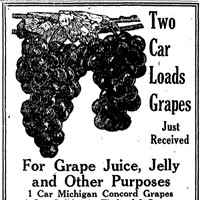
It is the 91st anniversary of the repeal of the 19th amendment and let’s celebrate with a few words. Prohibition was a long period in U.S. history, beginning in 1919, when most of the country was dry. I say that because you could still make your own wine should you be so fortunate to have access to grapes (with a permit you could make 200 gallons of homemade wine) or you could knock on the speakeasy’s door and get in with a special password. My grandparents were fortunate to pick up a distressed property in 1927 mid-Prohibition which included a shuttered winery and 25 acres of vineyard. They had to hold tight, farm the grapes and sell them to those home winemakers and wait for a few more years. Once the amendment was repealed on December 5 1933(better known as the 21st Ammendment), they dusted off the equipment and made wine in 1934. This year was our 90th vintage of producing wine, by the way.
While we don't face the same challenges of having a Prohibition today, there are many other challenges we face-as winemakers and grape growers. My hope is to enourage us all to continue with the traditions surrounding wine (for centuries!) and including this convivial beverage wherever there are friends and families, a meal or a visit, and enjoy the time spent reminiscing and celebrating those moments.
Let’s commemorate this day with a glass of your favorite wine. I’ll have Zinfandel for sure-it is hard to pick just one of ours but tonight I’ll have our Home Ranch Vineyard Legacy Block in my glass.
-
A Legacy Continues!
September 24, 2024 09:43

Part of the excitement of being a small family winery is I get to work with winemaker Montse Reece to develop new wines to add to our portfolio. She knows the vineyards well, this is her 18th harvest at Pedroncelli! These are small lot of single vineyard estate wines (blocks really) that are deemed exceptional in quality. In the coming months, we are introducing four new wines.
2022 Legacy Block Home Ranch Vineyard Zinfandel
The inaugural release of our Legacy Block Zinfandel is a celebration of the grape here at Pedroncelli. Our house is founded on this versatile grape and we now have four prime examples of what we and Dry Creek Valley can produce—stellar Zins!
Zinfandel has been planted on the property since 1904. The founders Giovanni & Giulia Pedroncelli purchased a shuttered winery, a home, and 25 acres of mostly Zinfandel in 1927. A second generation was planted on the property in the early 1980s. The Legacy Block was the third generation and was planted in 2016.
When Vineyard Manager Lance Blakeley was choosing the clone to plant on the 3 acres of hillside, he chose the Rockpile Clone which was developed to the north of us and proven to produce high quality fruit on steep hillsides. It also sets a smaller more manageable crop so the fruit ripens evenly. This is important because Zinfandel is a famous uneven ripener.
Once the vineyard began to produce fruit it caught winemaker Montse Reece’s eye. She noticed that it showed a different side of the Zinfandel grape-one she had not detected in our other Zinfandels. She described the aromas as distinctive with wild berries, licorice, pomegranate and baking spices.
The yeast she chose to ferment this Zinfandel was also derived from the Rockpile area and she feels complements the grapes while they ferment, bringing out the best in the fruit and adding complexity to the wine. The Legacy Zin is a very aromatic lighter-style zin. Montse uses American oak from Missouri with a lighter toast showcasing the fruit better without overpowering the wine.
The legacy indeed continues as we sourced the fruit from the our latest replanting of Zinfandel.
-
What is Grape Veraison
July 21, 2022 12:34
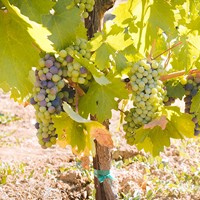
UNDERSTANDING GRAPE VERAISON
Each summer, grapes begin to change color in our Dry Creek Valley zinfandel vineyards. Grape veraison is the beginning of ripening, when red grapes change from green to purple colors. Veraison usually begins in July during moderate weather years, but in cooler vintages, zinfandel grapes don’t start changing color until late July, even early August at times. During ideal weather conditions, the time from coloration to harvest is typically about forty-five days.
There’s much more to grape veraison than the fascinating color change we can see with our eyes. To allow vines to focus all their energy into the existing clusters hanging on their shoots, the grapes cease growing during this period of their lifecycle. This allows sugars to increase and acids to decrease.
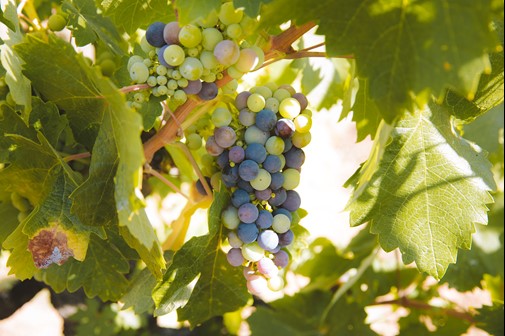
WHY EVEN GRAPE VERAISON IS IMPORTANT
Winemakers want the grape clusters to go through veraison quickly, because the uniformity of coloring within the clusters equals uniform flavors at harvest time. Being able to harvest uniformly ripened grapes is one of the keys to making a velvety, balanced Pedroncelli Zinfandel. If some grapes in the clusters are under-ripe, some perfect and some overripe, the finished wine will express some combination of too dry, too fruity and even too hot or high in alcohol. Only uniformly colored zinfandel grapes can make a balanced, smooth wine.
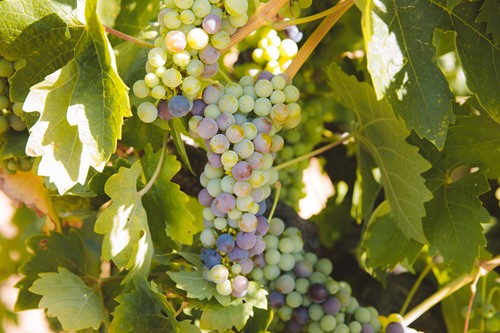
ADDRESSING UNEVEN COLORS DURING VERAISON
The warmer the weather, the more likely the grapes will change colors swiftly and uniformly. So, what does a winemaker do when the grapes change color unevenly? At Pedroncelli, we wait until veraison has taken 80% effect on our zinfandel vineyards, then we’ll start to trim off the “wings” and clusters that are still green. This sacrifice ensures the remaining grapes on the vine develop consistent flavors which will translate later into the wine.
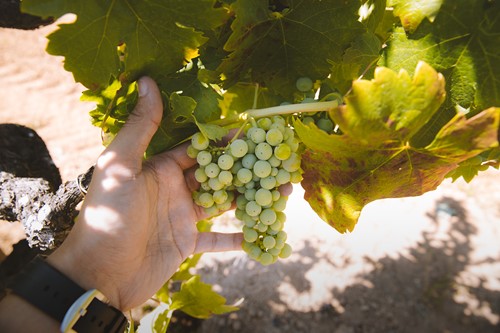
Here's an example of a cluster with a “wing.” A wing is a small bunch that shares the same shoot as a fuller cluster.
During ideal growing seasons, moderately warm temperatures help veraison happen at a perfect pace. Zinfandel, Cabernet Sauvignon and Merlot grapes start changing color in Dry Creek Valley during July and August, depending on when vineyard pruning occurred and the microclimate of each vineyard. In an average year, Pedroncelli’s Dry Creek vineyards complete veraison over two to three weeks.
DO GRAPES CHANGE COLOR AT DIFFERENT TIMES?
Different red grapes varieties go through veraison at different times. Just like during harvest, we don’t always pick the same grapes at the same time. It is spread out over several weeks. If Zinfandel is in veraison now, then we’ll be picking about the second week of September. Cabernet Sauvignon on the other hand has not even started veraison and we’ll expect to pick these grapes at the end of September or beginning of October. It always depends on the weather between now and then too.
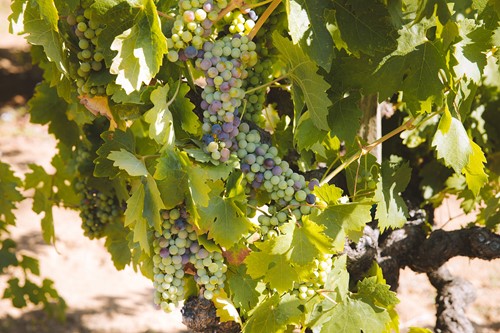
Follow us on social media to stay up to date with our harvest season.
-
Ped 101
May 31, 2022 14:49
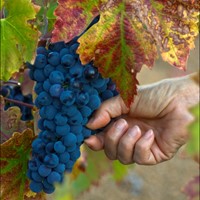
It is nice to have a long weekend every once in a while to reflect and take time out from busy schedules. Lately we have all been working at what feels like breakneck speed here at the winery as we build out our 10 year plan following strategy assessments and portfolio planning. And as we head into the 95th anniversary of our family business I would like to take a look back as well as forward.
Our tale begins when a young family was looking around for some property in 1927 with a GI Loan to back them up and some cash in hand to fund the purchase. A property was found near the town of Geyserville with vineyard, a shuttered winery (thanks to Prohibition) and a home. 90 acres of land located in Dry Creek. The American Viticultural Appellation ‘Dry Creek Valley’ didn’t come along until 1983. It must have been quite a move for the family to go from Dunsmuir California to Geyserville with no connections. The link to this new community was the vineyard. They could still sell the grapes to home winemakers which helped both the family and the vineyard to thrive and survive. Their ‘social’ network established them with other families and our story began.
Intertwined with our family history is Zinfandel. First planted on the property in the early 1900s it was the grape which became the foundation of our portfolio, and our flagship wine. What became known as the mother vineyard was replanted or cloned back into place becoming our Mother Clone. It continues today as the mainstay in our line of wines.
Another part of our story is told through Sonoma Classico, our red wine blend. My grandparents were new to winemaking when Repeal came around allowing them to now make wine commercially. They made wines from what was grown on the estate-Zinfandel, Petite Sirah, Carignane and maybe a little Golden Chasselas and Burger thrown in for good measure. It didn’t come with a varietal name as it was a field blend. Today this wine evokes those early years with the focus on estate fruit and is a classic on its’ own.
The next chapter continues with Cabernet Sauvignon. Second generation brothers Jim and John purchased property on West Dry Creek Road in 1965 and, based on market observations of what people wanted to drink, they planted this grape, the first winery in the valley to do so. Today we are on the second generation of vineyard there and now farm a total of 33 acres on the estate. Our Three Vineyards Cabernet is singular and reflective of the soil and climate. This wine deserves the designation of our second flagship.
Weaving white grapes into the mix, we have planted a few of them over the years. The early days we had Golden Chasselas and Burger, later French Colombard and Sauvignon Vert. These made way for Gewurztraminer and Riesling along with a bit of Chardonnay. They all had their time to shine depending on the era and we found Sauvignon Blanc, planted in the early 1990s, takes the prize as the longest planted. It is the grape which captures best the microclimate of Dry Creek Valley and reflects this in the wine itself. And having grown up 'Dry Creek' this is indeed a grape that deserves all the attention.
As we look to the future as a family some things will change and others stay the same-it is the age old story. We are building a strong base, as strong as the first generation and following generations. I look forward to sharing our journey with you. -
Blooming Vines
May 24, 2022 10:28

As I look across the way to our Mother Clone Zinfandel vineyards I can see they are growing quickly. Welcome to May which is the month our vineyards typically move into the next phase of growth. And yes vines do ‘bloom’ but they do it differently than your average daisy or rose. Those buds which began to grow through March and April are now ‘flowering’ from tight green pre-bunches to the phase where they open up or flower for a brief time and then crop set will follow and the future berries and bunches are formed. If you are into aroma therapy this is a good time to visit a vineyard just for the lovely sweet smell of bloom. It is a fleeting time so don’t delay!
Sometimes there are challenges during bloom time. What we don’t want is rain at this point-and it doesn’t look like we’ll have any as the days are ramping up into the 80s and 90s in our neck of the woods. This delicate phase also is vulnerable to frost (which happened a few weeks ago damaging some of the lower lying vineyards to the south and east of us) and high winds. All three are threats to the tender green shoots but especially to the future of the 2022 crop. And, of course, once the fruit has set following bloom our vineyard team will be able to predict the production for the upcoming harvest.
bloom time. What we don’t want is rain at this point-and it doesn’t look like we’ll have any as the days are ramping up into the 80s and 90s in our neck of the woods. This delicate phase also is vulnerable to frost (which happened a few weeks ago damaging some of the lower lying vineyards to the south and east of us) and high winds. All three are threats to the tender green shoots but especially to the future of the 2022 crop. And, of course, once the fruit has set following bloom our vineyard team will be able to predict the production for the upcoming harvest.
Each variety of grape grown on our estate grows at its’ own pace. The early bloomers tend to be Sauvignon Blanc and Sangiovese. Mother Clone Zinfandel sets its own pace as most of the vines are 40 years old and take their time with the season. Cabernet Sauvignon and Merlot will begin soon. The pace of the growing season mirrors when the grapes are picked-Sauvignon Blanc is always first in to the crushpad and Cabernet Sauvignon is our end of harvest grape.
We are anxious to see what this month brings to our vineyards and for the future harvest. The next stage is crop set followed by continued growth with veraison (the maturing and changing colors in the berries) around July and before you know it I’ll be talking about the first load of Sauvignon Blanc due in towards the end of August! The cycle of the growing season keeps everyone on their toes. Each year brings something unique to the vintage and the excitement to see what 2022 has in store for us is what keeps us going. 95 years and counting. -
88th Anniversary of Repeal
December 3, 2021 16:24

Each year we celebrate the anniversary the 21st Amendment—Repeal of the 18th amendment or the very long dry time known as Prohibition (1919-1933). Since my grandparents bought a distressed property mid-Prohibition (and probably hoped the end would come sooner than it did) this act began my families' legacy of making wine for nine decades and counting. Cheers to the 88th anniversary by toasting with Mother Clone Zinfandel which would be appropriate. For more on the history and how this period changed the way we drink, this TIME article with Daniel Okrent, author of Last Call: The Rise and Fall of Prohibition is a good read. https://time.com/5469508/prohibition-repeal-anniversary-history/
-
The Vines Tell Their Story
November 27, 2021 13:27

 The vineyard crew took advantage of the good weather to begin pruning the Mother Clone Vineyard this month. This is all part of the cycle a vine goes through and is the official entry into dormancy. We have had cool crisp fall mornings and the time is right to begin the process of pruning the 115 acres of vineyard by spring. Rainfall will delay some of those days and weeks so getting a head start is important.
The vineyard crew took advantage of the good weather to begin pruning the Mother Clone Vineyard this month. This is all part of the cycle a vine goes through and is the official entry into dormancy. We have had cool crisp fall mornings and the time is right to begin the process of pruning the 115 acres of vineyard by spring. Rainfall will delay some of those days and weeks so getting a head start is important.
Ever since I was young I have watched these vines with each season bringing something different-the new leaves of spring, the canopy of summer and harvest in the fall. Now winter is coming and they will take their dormancy seriously, stocking up on water and nutrients to get ready for another vintage. These head-pruned Zinfandel blocks have been through this for four decades. You can see it on their wizened arms.
When you look at a pruned vine you see the story it has to tell. From the placement of the arms to the whorls, knots and holes which are the scars of past pruning. These remind me of the rings of a tree in a way—they don’t tell the age of the vine but they certainly are the badges of age. Pruning shapes the vine in order to get the best direction for future shoots (which become canes and the canopy) so arm placement is key. The pruner comes through and clips away the old wood, the long canes that bore last year’s crop, and leaves two ‘buds’ on each arm-the 2022 vintage-in-waiting.
From the placement of the arms to the whorls, knots and holes which are the scars of past pruning. These remind me of the rings of a tree in a way—they don’t tell the age of the vine but they certainly are the badges of age. Pruning shapes the vine in order to get the best direction for future shoots (which become canes and the canopy) so arm placement is key. The pruner comes through and clips away the old wood, the long canes that bore last year’s crop, and leaves two ‘buds’ on each arm-the 2022 vintage-in-waiting. A few years ago we hosted a media group and Sara Lehman, SommInTheCity, was visiting the dormant vineyard. She remarked that each vine seemed to have its’ own personality. (The one to the left seems to have a lot of personality.) They are as individual as our own fingerprints, each one pruned to open up and help ripen the future fruit. Vines are like people as I have written before. They wilt a little under the heat of summer or grow in leaps and bounds in the youth of spring. And seeing is believing. This one has seen nearly 40 years and has survived. They are a lot like you and me. We are tough, flexible when needed and produce good fruit year after year.
A few years ago we hosted a media group and Sara Lehman, SommInTheCity, was visiting the dormant vineyard. She remarked that each vine seemed to have its’ own personality. (The one to the left seems to have a lot of personality.) They are as individual as our own fingerprints, each one pruned to open up and help ripen the future fruit. Vines are like people as I have written before. They wilt a little under the heat of summer or grow in leaps and bounds in the youth of spring. And seeing is believing. This one has seen nearly 40 years and has survived. They are a lot like you and me. We are tough, flexible when needed and produce good fruit year after year. -
That (Wine) Time of Year
November 22, 2021 15:07

It will come as no surprise to you that fall is my favorite season. I revel in the changes all around me. The colors in our Mother Clone vineyard outside my office window are muted by the clouds, which are due to bring rain soon. It seems to be the right time to reflect on the year so far, with just six weeks until the New Year, and it’s as good a time as any for wine.
This week National Zinfandel Day has come and gone, Nouveau Beaujolais had its’ day and Cabernet Franc will soon be celebrated in December. Did you know there are 15 National Wine Days throughout the year and another 35 International Days set aside for everything from Chardonnay to Xinomavro? Sometimes I feel like the kid in the proverbial candy store. There are so many wines out there to try and we have 18 of our own currently released as of this note. A wine for every table and palate.
Thinking of all the ways wine is part of this time of year includes gifting for the holidays (I’d like Santa to add a bottle of wine to my stocking), featuring a favorite wine or two on the table, and don't forget the midweek meal choice amidst the busyness of wrapping up gifts or the year. This brings holiday menus to mind. The age old question of which wines goes with the bird or roast beast comes around again. Long ago when I worked in the Tasting Room, learning the ropes, I would tout our Rosé as the Thanksgiving wine: it goes with everything from the turkey to the cranberry sauce, maybe even pumpkin pie-give it a try.
And if you go ask Google you’ll find wine and food pairing lists for the holidays nearly as long as the circumference of the earth. What do we do? I’ll make it easy for you. Go with the wine you love best-why not have your favorite wine on the table? I would only make a few adjustments to the food. Watch the salt (not just because Ed and I are doing a lot of that lately) but because, like anything else, too much will throw the pairing out of balance. Other things like fat, usually a wine’s best pairing friend, will ease the concerns whether a wine is right or not. Enter gravy, buttered rolls, roasted veggies.
This time of year I think less complication is better. Dig into your cellar/coat closet/wine rack and pull out a wine you’ve been saving for a special occasion. Bubbly always has a spot somewhere on the table at our house and of course dessert and Port go hand in hand (now pumpkin pie is a great pairing with Port!). No matter what, I believe we all will make the right choice.
Reflecting on the past months I, for one, am glad harvest came through without a hitch, and although we are experiencing supply issues we are working on solutions. The virus continues as well as the ebb and flow of pandemic rules. In the middle of it all sometimes a pause in our daily routine to enjoy time with friends or family feels good, especially when there is a glass of something tasty to go along with the conversation. -
Every Day Should Be National Zinfandel Day
November 15, 2021 08:29

We are looking forward to celebrating National Zinfandel Day on November 17. I put together a retrospective on this flagship grape and the lineage it has at Pedroncelli and in Dry Creek Valley. Our family’s legacy has been intertwined with this variety for 94 years.
The first family who owned the property, the Canatas, were the first to plant Zinfandel here. They built a small winery and made the wine for their store in North Beach, San Francisco. They operated from about 1906 to 1919 when Prohibition put a halt to all winemaking and began a 14 year moratorium on commercial winemaking. There was hope however for this family-they were able to sell grapes to head of households who obtained a federal permit and could make up to 200 gallons of wine (that’s about 84 cases). Needless to say there was a high demand in the early years of the dry time but soon the bottom dropped out of the grape market.
My grandparents bought the distressed property from the family in 1927 by putting together a Veteran’s loan and cash for a total of $11,000. The 90 acres of land had a thriving 25 acres of Zinfandel and a home for Giovanni, Julie and their children. They continued to farm the grapes and sell them to home winemakers. I imagine my grandfather, who was not a winemaker at the time of the purchase, had the next 7 years to learn and hone his craft.
Enter Repeal and the beginning of Zinfandel as our focus wine, since it was the main variety planted at the time. Blends were the common way to make wine It remained so until the 1940s when expansion of vineyard began and we branched out. In 1948 we first used Zinfandel on the label instead of Claret. By the 1950s we were making a Rose out of Zinfandel (and continue to make it after more than 65 vintages).
1950s we were making a Rose out of Zinfandel (and continue to make it after more than 65 vintages).
The ensuing years brought many changes to the market but we continued with our focus on this flagship wine. The Renaissance of wine in Sonoma County began in the 1970s and the grape of choice for Dry Creek Valley became Zinfandel with Cabernet close on its heels. Today half of all Zinfandel planted in Sonoma County is in Dry Creek Valley-2500 acres.
Replanting of our Mother vineyard on the Home Ranch began in 1980 and took about 5 years. The blocks were cloned back into place with St. George rootstock, same vine spacing, head-pruned (or goblet shape) using budwood from our own and also sourced from neighbors.
The 1990s brought a change in how we shaped our portfolio and we went from a main Zinfandel bottling to introducing our Mother Clone and Pedroni-Bushnell Vineyard selections. This highlighted specific vineyards and styles. Our Mother Clone Zin carries the long tradition of blending Petite Sirah to bring structure and depth-going back decades as our house style. Our Pedroni-Bushnell honored three generations of family ownership beginning with my grandfather who owned the property and then sold it to his daughter Margaret and son-in-law Al Pedroni. Daughter Carol Bushnell and husband Jim took the reins in 1992. Today we simplified the name to Bushnell and it is a specially selected block that brings true spice and berry to your glass.
and styles. Our Mother Clone Zin carries the long tradition of blending Petite Sirah to bring structure and depth-going back decades as our house style. Our Pedroni-Bushnell honored three generations of family ownership beginning with my grandfather who owned the property and then sold it to his daughter Margaret and son-in-law Al Pedroni. Daughter Carol Bushnell and husband Jim took the reins in 1992. Today we simplified the name to Bushnell and it is a specially selected block that brings true spice and berry to your glass.
Steady as she goes defined the first 15 years of the 21st century. In 2016 winemaker Montse Reece assessed the excellent fruit from the Faloni Ranch, a 3 generation grape growing family, and wanted to make another single vineyard. Named Courage, as in it takes a lot of courage to not only farm Zinfandel but to make it as well. At about this time a portion of the Home Ranch was replanted with the Rockpile Clone which has a history of doing well on hillsides. We dedicated the vineyard at our 90th Anniversary Celebration in 2017. For now the fruit is part of the Mother Clone blend. We'll see where the future takes us as we refine and perhaps redefine Zinfandel.
excellent fruit from the Faloni Ranch, a 3 generation grape growing family, and wanted to make another single vineyard. Named Courage, as in it takes a lot of courage to not only farm Zinfandel but to make it as well. At about this time a portion of the Home Ranch was replanted with the Rockpile Clone which has a history of doing well on hillsides. We dedicated the vineyard at our 90th Anniversary Celebration in 2017. For now the fruit is part of the Mother Clone blend. We'll see where the future takes us as we refine and perhaps redefine Zinfandel.
This lineage which has wound its’ way throughout the history of Pedroncelli is one we can be proud of and share with our friends. On National Zinfandel Day raise a toast and, as I said in the subject line, every day should be a celebration of America’s grape. -
Vintage Notes
March 30, 2021 16:22

This is the first of a monthly blog post on wines from our cellar here at the winery. Ed, Colin and I have been taking apart stacks of wines in our warehouse and inventorying them. We of course need to taste them to make sure they are doing fine, drink now or forget about it.
It began last month with Open That Bottle Night but as we delved into the cases of wine stacked in and around the warehouse we realized doing some tasting notes on these gems would be a good thing to have here on Vino in my Dino.
2009 Merlot
Cork Finish
This was a nice surprise. The very mellow wine with touches of red brick around the edges of the glass. Softened by age this Merlot still has the stuffing to age another year or two. The beauty of this gem is it is ready to drink now should you have some in your cellar-a few more years will be okay as well.
2002 Alexander Valley Cabernet Sauvignon
Cork Finish
From the Morris Fay vineyard this is a wine that has aged quite well. Notes of tobacco, leather and a nice fruit core of cherry on the aromatics as well as flavor. A long finish is framed by softening, but not too soft, tannins signaling this wine will age well for a few more years.
2001 Block 007 Cabernet Sauvignon
This is the first year we made a small lot wine from this block. And I am here to tell you this has aged beautifully. Notes of dried herbs linger on the nose along with touches of plum and black pepper spice.
2016 Signature Selection Chardonnay
Screw Cap
Not much color change-a deepening gold perhaps from the pale yellow of first release. Still lively with mellowed aromatics of melon and apple. Acidity is still bright, the flavors are rich and the finish is heightened by the perfect balance of fruit and acidity.
Categories
- COVID
- Follow the Vineyard
- Note from Home
- PairItWithPed
- Pandemic
- pedroncelli
- Port
- Postcards from Home
- Pruning
- Seasons in The Cellar
- Tasting Room
- Thanksgiving
- Vintage Notes
- Winemaking
- Women's History Month
Recent posts
-
91 Years Later
-
Come Over October: It's About Community
-
Come Over October
-
A Legacy Continues!
-
Everything Old is New Again
Popular tags
- Courage Zinfandel
- French Oak
- Sonoma County
- Heat wave
- Schotzki
- OpenThatBottleNight
- note from home
- Rosé
- Pedroncelli
- family
- Four Grapes Port
- Cellar Master
- 1974 Cabernet Sauvignon
- Down to Earth
- Follow the Vineyard
- Holding steady
- PairitwithPed
- Reserve
- cooking with wine
- Mother Clone
- Block 007 Cabernet Sauvignon
- Homecooking
- Barrels
- newsletter
- Pandemic
- Cookies
- Merlot
- COVID Coffee Chat
- Estate Vineyard
- COVID19
- Oak
- Easter
- Cabernet Sauvignon
- Pruning
- Recipes
- Sauvignon Blanc
- Harvest 2022
- cheese
- Lake Sonoma
- Seasons in The Cellar
- Anniversary
- Pantry
- Habit
- Finding Your Roots
- Dry Creek Valley
- food and wine
- Crop set
- American Oak
- Library Wine
- Bushnell Vineyard









